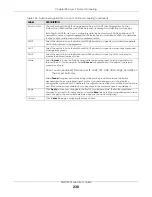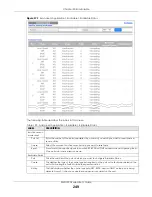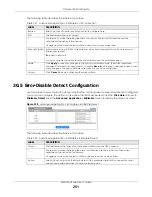
Chapter 28 Layer 2 Protocol Tunneling
XMG1930 Series User’s Guide
238
Point to Point
The Switch supports PAgP (Port Aggregation Protocol), LACP (Link Aggregation Control
Protocol) and UDLD (UniDirectional Link Detection) tunneling for a point-to-point topology.
Both PAgP and UDLD are Cisco’s proprietary data link layer protocols. PAgP is similar to LACP
and used to set up a logical aggregation of Ethernet ports automatically. UDLD is to determine
the link’s physical status and detect a unidirectional link.
PAGP
Select this option to have the Switch send PAgP packets to a peer to automatically negotiate
and build a logical port aggregation.
LACP
Select this option to have the Switch send LACP packets to a peer to dynamically create and
manage trunk groups.
UDLD
Select this option to have the Switch send UDLD packets to a peer’s port it connected to
monitor the physical status of a link.
Mode
Select
Access
to have the Switch encapsulate the incoming layer 2 protocol packets and
forward them to the tunnel ports. Select
Access
for ingress ports at the edge of the service
provider's network.
Note: You can enable L2PT services for STP, LACP, VTP, CDP, UDLD, PAgP, and LLDP on
the access ports only.
Select
Tunnel
for egress ports at the edge of the service provider's network. The Switch
decapsulates the encapsulated layer 2 protocol packets received on a tunnel port by
changing the destination MAC address to the original one, and then forward them to an access
port. If the services is not enabled on an access port, the protocol packets are dropped.
Apply
Click
Apply
to save your changes to the Switch’s run-time memory. The Switch loses these
changes if it is turned off or loses power, so use the
Save
link on the top navigation panel to save
your changes to the non-volatile memory when you are done configuring.
Cancel
Click
Cancel
to begin configuring this screen afresh.
Table 109 Advanced Application > Layer 2 Protocol Tunneling (continued)
LABEL
DESCRIPTION
















































